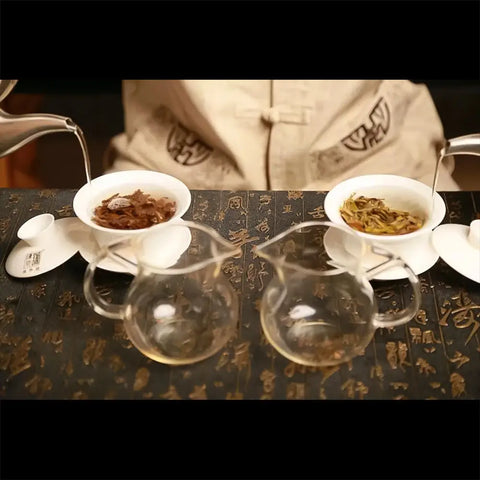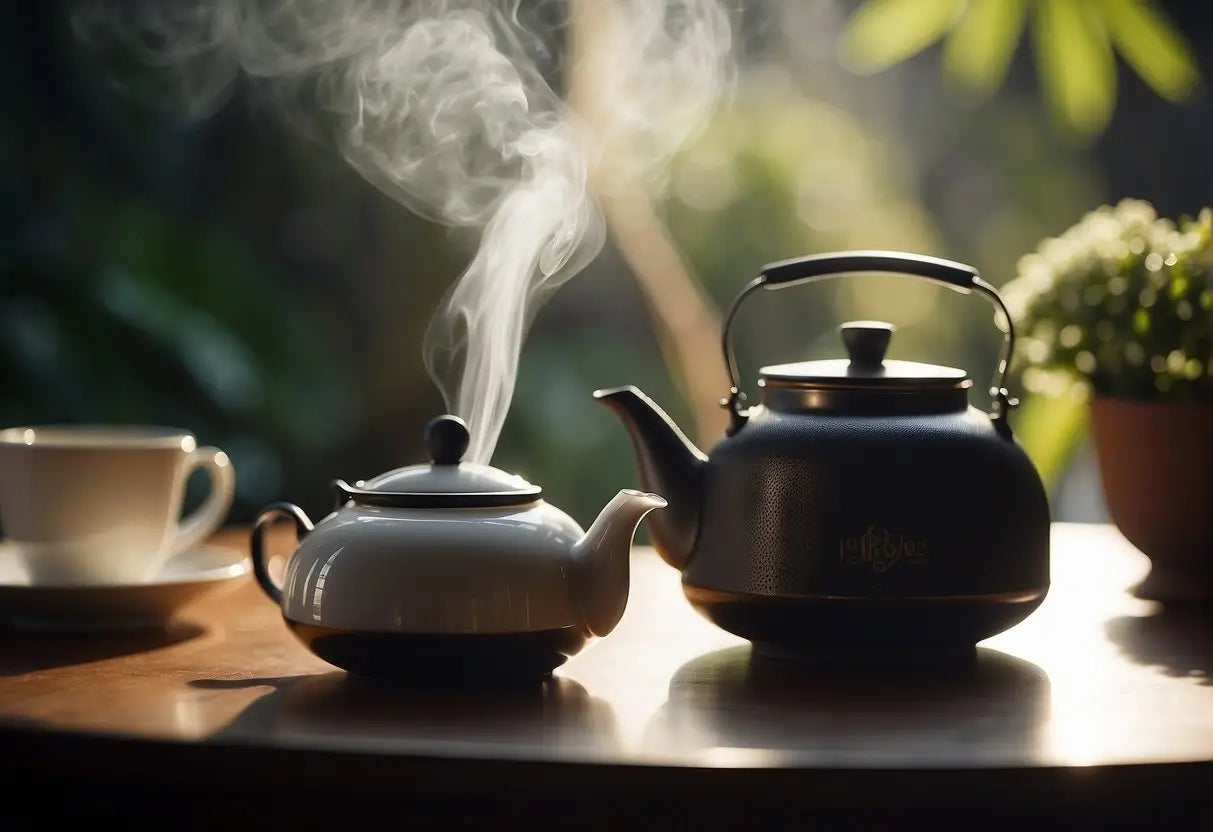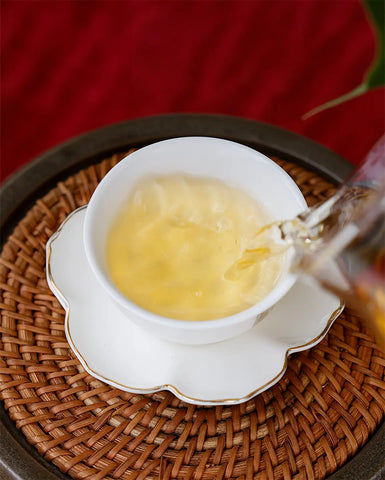How to Steep Tea
Proper tea steeping unlocks the full flavor and potential health benefits of your tea leaves. Key factors include the type of tea, water temperature, and steeping time.
Types of Tea
Black Tea: Fully oxidized, robust flavor.
- Optimal Temperature: 95-100°C (203-212°F)
- Steeping Time: 3-5 minutes
Green Tea: Minimally oxidized, delicate taste.
Bestsellers
- Optimal Temperature: 75-80°C (167-176°F)
- Steeping Time: 2-3 minutes
White Tea: Least oxidized, subtle and sweet.
- Optimal Temperature: 65-70°C (149-158°F)
- Steeping Time: 4-5 minutes
Oolong Tea: Partially oxidized, diverse flavors.
- Optimal Temperature: 80-85°C (176-185°F)
- Steeping Time: 3-5 minutes
Herbal Tea: Not from the Camellia sinensis plant, varied ingredients.
- Optimal Temperature: 95-100°C (203-212°F)
- Steeping Time: 5-7 minutes
Optimal Water Temperature
Your tea's flavor can benefit significantly from using the right water temperature. Here's how to determine the ideal temperature for different types of tea:
- Boil water and let it sit for a couple minutes to reach the correct temperature for green or white teas.
- For black and herbal teas, use water that is just off the boil.
- An electric kettle with temperature control can provide precise temperatures.
Steeping Time Variations
Adjust steeping time to taste but be wary of oversteeping, which can result in bitterness. Use these recommendations:
- Green Tea: Start with a 2-minute steep and increase as desired.
- Black Tea: Begin with 3 minutes and adjust for strength.
- White Tea: Can often withstand longer steeping times, start with 4 minutes.
- Oolong Tea: Oolong varies greatly; begin at 3 minutes and modify for flavor.
- Herbal Tea: Contains no tea leaves, so it's less likely to become bitter. Start with a 5-minute steep.
MONITOR steeping closely to achieve the perfect cup.
Preparation Basics

The foundation of a perfectly steeped tea begins with selecting appropriate teaware and understanding the importance of water quality as well as its source.
Choosing the Right Teaware
When selecting teaware, consider the material and size to enhance your tea experience. Porcelain or glass is ideal for white and green teas, as they retain heat without adding any flavor. For black and oolong teas, ceramic or clay teawares are preferable as they absorb flavors, enriching subsequent brews. Use a small teapot or a brewing cup with an infuser for single servings.
Water Quality and Source
The quality and source of water are crucial:
- Filtered Water: Use filtered water to remove any odors or impurities that can alter the taste.
- Spring Water: Natural spring water is the best choice if available, due to its balanced pH and mineral content.
- Avoid Tap Water: Unfiltered tap water can contain chlorine and other contaminants that may affect the taste.
Steeping Techniques
Proper steeping is crucial to extracting the full flavor profile of the tea leaves. Below are methods to steep tea, detailing both traditional and contemporary techniques.
Traditional Steeping Method
When using the traditional steeping method, it's important to start with fresh water, preferable filtered or bottled, for the best taste. Heat your water to the appropriate temperature for the type of tea you are brewing—black, oolong, green, white, or herbal teas each have their own requirements.
Lao Ban Zhang
Temperature Guide:
- Black Tea: 190-212°F (87-100°C)
- Oolong Tea: 185-205°F (85-96°C)
- Green Tea: 150-180°F (65-82°C)
- White Tea: 160-185°F (71-85°C)
- Herbal Tea: 212°F (100°C)
Steps:
- Preheat your teapot or cup to maintain the water temperature by filling it with hot water; then discard the water.
- Add 1 teaspoon of loose leaf tea per 6-8 oz (approx. 180-240 ml) of water into the teapot or infuser.
- Pour the water over the tea leaves and let them steep for the right amount of time.
Steeping Times:
- Black Tea: 3-5 minutes
- Oolong Tea: 4-7 minutes
- Green Tea: 2-3 minutes
- White Tea: 4-5 minutes
- Herbal Tea: 5-7 minutes
After the appropriate time, remove the tea leaves to avoid overbrewing, which can make your tea taste bitter.
Cold Brew Method
The cold brew method involves steeping tea leaves in cold water for an extended period. This technique often yields a lighter, smoother taste and is perfect for making iced tea.
Instructions:
- Place about 1.5 times the amount of tea leaves you'd use for hot brewing into a pitcher.
- Fill the pitcher with cold, filtered water.
Ratio Guide:
- 1 to 1.5 teaspoons of tea per 6-8 oz (approx. 180-240 ml) of water.
- Cover the pitcher and place it in the refrigerator.
- Steep for at least 6 hours, though some teas may benefit from up to 12 hours.
When ready, strain out the tea leaves. Cold-brewed tea can be served as is or with ice, and due to its mild nature, it rarely becomes bitter, even after extended steeping.
Serving Suggestions

When serving tea, consider the type of tea and the time of day to enhance your experience. Black tea pairs well with many breakfast items, while green tea is refreshing later in the day.
Tea Types and Pairings
- Black Tea: Complements hearty breakfast foods such as eggs, bacon, or toast.
- Green Tea: Ideal with lighter foods, think salads or lightly salted snacks.
- Herbal Tea: Pairs well with desserts; chamomile is perfect with a delicate pastry.
Temperature & Steep Time
- Hot Tea: Serve immediately after steeping; ideal for cooler weather or to start your morning.
- Iced Tea: Chill after steeping and serve with ice; best for warmer seasons or an afternoon refresh.
Accompaniments
- Milk: A splash in black tea can soften its robust flavor.
- Sweeteners: Honey or sugar enhance flavor, but use sparingly.
- Lemon: Adds a zesty note, especially to black and green teas.
Glassware and Utensils
- Use clear glasses to appreciate the color of the tea.
- Porcelain cups are classic and maintain heat well.
- Stainless steel spoons are durable and won't impart flavors.
Enjoy your tea in a calm setting to fully appreciate its aroma and taste. Remember, these suggestions are merely a starting point, your personal preference is key.
Cleaning and Maintenance
Proper cleaning and maintenance of your teaware will ensure the best flavor for your tea and extend the lifespan of your teaware.
Teaware Cleaning Tips
After Each Use:
- Rinse your teapot and cups with hot water to remove tea residue.
- Use a soft sponge without abrasive cleaners to avoid scratching the surface.
Weekly Cleaning:
-
For Teapots/Cups:
- Fill with a solution of one part baking soda to three parts water.
- Let soak for several hours, then rinse thoroughly with warm water.
-
For Stains:
- Dampen the stained area and apply a small amount of baking soda.
- Gently scrub with a soft brush then rinse well.
Deep Cleaning:
-
For Tough Buildup:
- Combine equal parts vinegar and water in the teapot.
- Boil this mixture and allow it to sit overnight, then rinse thoroughly.
Storage Tips:
- Ensure all pieces are completely dry before storing to prevent mold and mildew.
- Store your teaware in a cool, dry place away from direct sunlight and strong odors which can be absorbed.
Remember:
- Do not use harsh chemicals or steel wool on teaware to prevent damage.
- Check for specific care instructions from the manufacturer as materials can vary.
Advanced Tips

In this section, you will gain insights into perfecting your tea brewing with precision in steeping time and temperature, as well as enhancing your tea experience by experimenting with various tea blends and flavors.
Adjusting Steeping Time and Temperature
| Tea Type | Temperature | Steeping Time |
|---|---|---|
| Green Tea | 150-175°F (65-80°C) | 1-3 minutes |
| White Tea | 160-185°F (70-85°C) | 4-5 minutes |
| Oolong Tea | 180-200°F (82-93°C) | 2-3 minutes |
| Black Tea | 190-212°F (88-100°C) | 3-5 minutes |
| Herbal Tea | 212°F (100°C) | 5-7 minutes |
Fine-tune the specifics according to the tea variety. Start with lower temperatures for delicate teas to prevent bitterness. Increase steeping time incrementally for bolder flavors.
Experimenting with Blends and Flavors
- Blending Basics: Combine teas that have compatible flavor profiles. Example: merging a citrusy Earl Grey with a spicy Chai.
- Flavor Enhancers: Consider adding herbs (mint or lemongrass), spices (cinnamon or cardamom), or floral notes (rose petals or lavender) to introduce new dimensions to your brew.
Incorporate tasting notes by first blending in small test batches, ensuring that no single flavor overpowers the others. Adjust ratios as needed to achieve your desired blend.
Frequently Asked Questions
In this section, you'll find specific information on steeping times for various teas, detailed steps for loose leaf and tea bag brewing, and tips for steeping tea on the stove.
What is the proper duration to steep different types of tea?
For green tea, steep for 1-3 minutes using water at 150-180°F. Black tea requires 3-5 minutes with water at 190-212°F. Oolong should be steeped for 3-5 minutes at 180-200°F, and herbal teas often require 5-7 minutes with boiling water.
Can you walk me through the steps for steeping tea using loose leaves?
Heat water to the desired temperature. Put 1-2 teaspoons of loose leaf tea per cup into a tea infuser. Place the infuser in your cup and pour hot water over the tea leaves. Steep for the recommended duration, then remove the infuser.
What is the best method to steep tea if I don't have a tea bag?
Use a tea infuser or a French press. Measure the tea leaves, add them to the infuser or press, and pour hot water over them. Steep for the correct amount of time, then remove the infuser or press the plunger down to separate leaves from the liquid.
Could you explain the process of steeping tea using tea bags?
Heat your water to the appropriate temperature. Place the tea bag in your cup and pour hot water over it. Let it steep according to the type of tea, then gently remove the bag to avoid squeezing out bitter tannins.
How can I steep tea successfully on the stove?
Place water in a pot and heat to the desired temperature. Once hot, add the tea leaves either directly into the pot or in a strainer. Turn off the heat and allow the tea to steep for the required time. Strain the leaves if necessary before serving.
Is it necessary to remove the tea bag after steeping, and why?
Yes, you should remove the tea bag after the recommended time to prevent over-steeping, which can lead to a bitter taste. Steeping for the proper duration ensures a balanced flavor profile.
← Older post Newer post →











